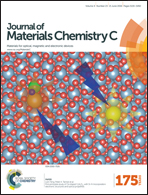Fabrication of nickel oxyhydroxide/palladium (NiOOH/Pd) thin films for gasochromic application†
Abstract
A new chromogenic nickel oxyhydroxide (NiOOH) thin film was prepared to integrate both its electrochromic and gasochromic characteristics. The NiOOH thin film was obtained using the chemical bath deposition (CBD) method, and was annealed at 300 °C for 2 hours and then subjected to cyclic voltammetry (CV). A palladium catalyst layer was then sputtered onto the NiOOH thin film and the film was prepared for gasochromic application. A large transmittance change (ΔT) was observed, specifically 50.6% at 650 nm and 47.0% at 550 nm, after exposure to hydrogen (H2). The unique memory effects of the chromogenic nickel oxide thin film, which can maintain colour for at least 21 days without significant optical changes, were observed before and after exposure to H2. The bleached film can be switched back to the dark state by applying 0.6 V on the thin film owing to its electrochromic properties. X-ray photoelectron spectroscopy (XPS) analysis was used to confirm the changes in chemical bonding before/after CV treatment and also to confirm that the Pd layer existed on the NiOOH surface. Surface electron microscopy (SEM) images showed highly porous surface morphology after CBD and CV treatment. XRD patterns and FT-IR spectra indicated the structural changes that occurred during film preparation and before/after exposure to H2.



 Please wait while we load your content...
Please wait while we load your content...